After three nights enjoying relatively posh Manang, we continue our climb toward the pass and head to Yak Kharka (elevation 13,188 feet). “Kharka” means pasture, and true to its name we pass dozens of yaks grazing along the trail. Yaks are big, beautiful animals, and many are adorned with yarn necklaces or earrings. Our suspicion is that the different colored ornaments designate different owners; a kinder, gentler, and prettier version of branding.
It is a good day for wildlife spotting too. We see herds of blue sheep and musk deer across the river canyon, and two spectacularly enormous Himalayan griffons feasting on a dead donkey. Half as long as the donkey, we estimate these birds must weigh close to 50 pounds each.
Yak Kharka is a small collection of a few lodges. Ours is simple and clean, and we are back to shared outside toilets. Oh, and no more showers (or running water for that matter) until we reach Muktinath – two nights away and over that nearly 18K’ pass. Like all the settlements between Manang and Muktinath, Yak Kharka is occupied only seasonally, as the lodges close and workers head to Manang or lower during the winter months.
Despite the high altitude we both feel pretty good. Slight headaches, but a couple liters of water, a few ibuprofen and a good night’s sleep cure us.
Our next day’s destination is Thong Phedi (elevation 14,895 feet) – the jumping off point for the following day’s push over Thorung La. It takes us about three hours to get there, crossing arid hills and a marked landslide area. The days are not long, but the elevation starts to become tangible, and Mark begins to feel a little loopy when pushing hard.
We arrive in Thong Phedi with several hours to relax at the lodge. We snack on oil-popped popcorn (reminds us of childhood, and what popcorn used to taste like!) and drink large thermoses full of “Hot Lemon”, a sugar-saturated lemon-flavored drink that helps us stay hydrated while not loading us up with caffeine.
We relax with many trekkers around the communal tables, and discover that many are feeling the effects of the altitude too. There is a pensive excitement as we anticipate the next day’s events, everyone wondering how their bodies will react. Will we make it over the pass on our own steam, or will we take the ride of shame, hiring a donkey to give us a lift over the top?
We turn in early, trying to get as much sleep as possible before our 3:00 AM wake-up call. Why so early? Weather in the Annapurnas follows a consistent pattern: clear and still in the morning, but by mid-morning the wind picks up and clouds form, most often obscuring the mountains. Pemba wants us to cross Thorung La by 9:00, as the area between the Thorung peaks turns into a giant wind tunnel by 10:00.
Neither of us sleeps well. I have a stuffed nose and head and believe I am suffering from allergies (the mattresses and sheets at the lodges are seldom cleaned), but later discover that I have a drippy cold. Our alarm sounds at 3:00 and a sleepy-eyed Pemba knocks on our door a few minutes later. After a quick we’re-not-awake-let-alone-hungry-but-really-should-eat breakfast, we are on the trail at 4:18 AM.
It is dark. It is cold. And it’s snowing. We are higher than the top of Mount Whitney, but the trail only goes straight up. The world is reduced to the small circle a few feet in front of us illuminated by our dim headlights, and occasionally the distant flash of a headlight from a group of trekkers ahead of us that left at an even more ungodly hour. We climb like this for the first hour, slowly and tentatively but surely.
After an hour of climbing up a long set of switchbacks, the sky begins to glow, and we can see a few breaks in the clouds, and then the outline of a few mountains. Mark looks ready to find the nearest donkey, but with dawn his body begins to show signs of life. The landscape is barren and silent. No plants. No animals. No sounds of water flowing. It is stark and beautiful, and the snow gradually changes hues as the sun begins to add color to the sky.
And then a new sound – donkey bells. A few unlucky trekkers are taking donkeys to the top of the pass. Mark is not among them. In fact, Mark discovers that by pushing ahead for 30 or 40 steps, then resting for 30 or 40 seconds, he can keep up a decent pace without fear of blacking out. This becomes our strategy to reach the top – push ahead a few steps, rest a bit, repeat. We climb to the top of one glacial moraine only to find another, slightly higher, waiting behind it. Then another, and another.
Nearly three hours and nearly 3,000’ above Thong Phedi, we finally see a set of prayer flags that marks a spot 15 minutes from the summit. 30 minutes later, we find ourselves standing next to a chorten, surrounded by more prayer flags, a swarm of other trekkers high-fiving and drinking tea, and discover that we are staring into multiple cameras next to a sign congratulating us for making it the top of one of the highest trekking passes in the world. At nearly 18K’, we find ourselves still looking up to peaks nearly 10,000 feet higher than where we stand.
A bit dazed but elated to know that after 12 days of climbing more than 25K’ the word “down” is no longer just a hypothetical construct, we take photos and then enjoy a brief tea break at the pass’ tea shop (yes, there actually is a tea shop built at the pass), then take a few steps more and find ourselves moving our legs in a consistent manner that we haven’t felt for nearly two weeks: down!
Our sleep spot for the night is Muktinath (elevation 12,467 feet), and so we have a long descent ahead of us. Much of the descent is on roughly hewn stone steps, and after a couple hours I begin to feel pain in my left knee. This pain steadily increases as we climb down. When we finally reach Muktinath – five hours later – I am alternately limping, swearing, and blowing my cold-plagued nose.
Mark’s knees are holding up, but he is feeling the delayed effects of our high altitude morning; he is experiencing a wicked headache.
We finally arrive in Muktinath and learn our guest house is at the far end of town. What would normally be a 15-minute stroll takes us half an hour at my new limp-constrained pace. We arrive and collapse.
After a gas-powered hot shower, we begin our next task: laundry. With no running water for a few days and limited drying abilities in Manang (too cold and cloudy), it is time to get the stink out. One bonus of hiking in high, cold places is that things don’t smell as much, and bacteria grows slower (or not at all). But in sunny, lower Muktinath there is no escaping the fact that we smell bad. Shower, laundry, dinner, and in bed by 8:00 PM.
Oh, and as promised, our first beer in nearly two weeks!
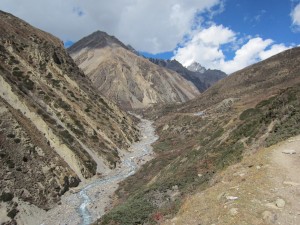
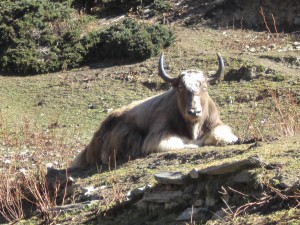
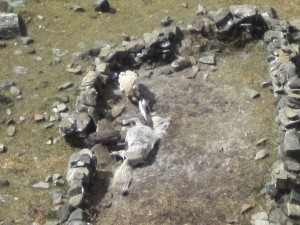
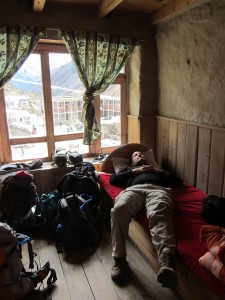
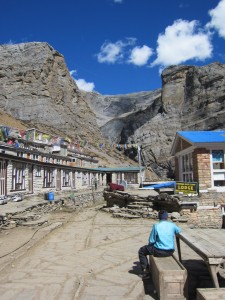
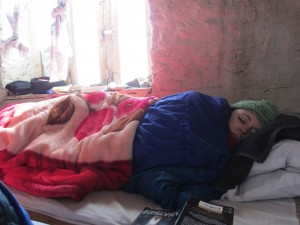
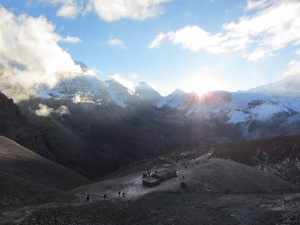
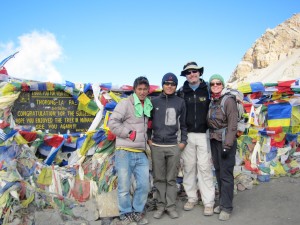
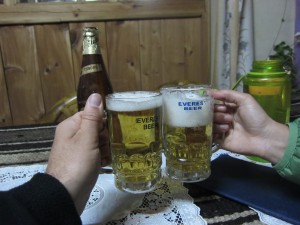
{ 4 comments… read them below or add one }
WOW. You guys did it – and no donkeys! It looks stunning – can’t believe how blue that sky is. Allie, hope your knee recovers and Mark, that the beer did not worsen your headache!
Thanks Ann 🙂 We both recovered – the power of Advil and rest is not to be underestimated!
Wow, what a climb. What great photos too!
Years ago Connie and Iwere climbing down Mount Washington in New Hampshire (A mere 6,288 feet) and we were both struck how much harder on our knees a decent was.
We hope you are both fully recovered.
Steve
Hi Steve,
Knees are good now; rest and drugs do wonders! We found that hiking poles help A LOT too…they are our new permanent hiking accessory!